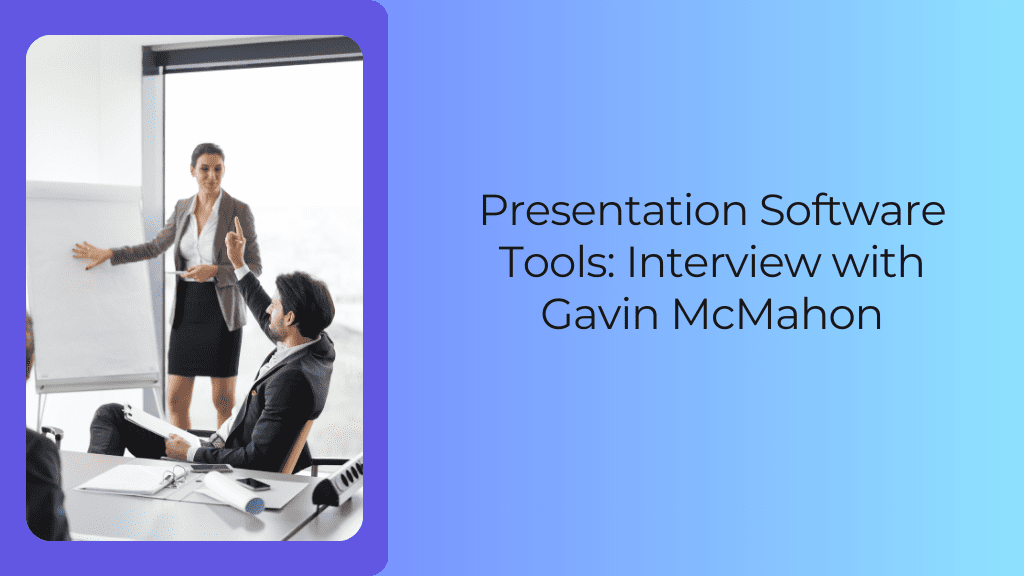We had the pleasure of chatting with presentation expert Gavin McMahon surrounding his insights on presentations as it relates to sales and marketing. Gavin McMahon is a senior partner and co-founder of fassforward Consulting Group. Over the past several years Gavin has advised Fortune 100/500 companies on the impact of market changes and their interrelationship with marketing and business strategy. He brings a unique perspective on growth and innovation, as well as an understanding of the barriers to achieving desired results in these areas. Here’s part one of two of our interview with Gavin.
In your experience whether it’s PowerPoint, video, giving people talking points or whiteboards, what presentation tools out there do you think help or hinder getting the message across?
I think these tools are completely fundamental to getting the message across. If you imagine you have words, structure, pictures, or any creation of those and you’re fairly strong with two of them but weaker with one of them, what you’re trying to do is to get the tool to fill in where you’re lacking. Whether it’s the whiteboards, PowerPoint, CustomShow, or anything else, this tool helps to fill in the weak spots that you have.
For example, I’m a words last person. My biggest nightmare is wanting to say something and forgetting that I have this perfect way of saying it and then locking up because of that. So if I can’t remember the words, I want the tool to remember the words for me. I don’t want a teleprompter, but I want it to remember the words for me. If I’m not naturally funny or engaging, I want the figures presented with me to be funny and engaging- assuming it’s appropriate for the context of course. If I’m not naturally structured and organized and disciplined in my narrative and talk track, I want the tool that’s with me to give us both in this conversation a narrative and stepping stones to follow along. So I think the tool is a ying and yang. Both things work together and the people who fly solo without these things tend to do a much poorer job.
Do you treat problems or issues differently when you’re thinking about an individual presentation, like an executive’s keynote or a presentation that you have to give in a conference, versus materials that might be used across an entire organization, so like the marketing tools being used for an entire sales team or all of the thousand employees?
The short answer is yes- you have to. In the one-on-one situation, or the one person presenting to a keynote, or one person presenting to small board, what you can begin to do is identify two or three key decision makers, or key decision types, and craft it around their objections.
Once you begin to scale up, you have to account for many more things, but you can still use the same fundamental principles, you can still use the same deck or the same kind of piece in different ways. Storytellers can use it in one way; inventors can use it in another, it just completely depends. In a sales situation, it’s a much better meeting if you do less of the talking.
So the question is, how do you give a sales person enough context in the presentation to seem interesting and have a good conversation? The goal is to have the buyer say, ‘Well, I think that went well, can you call me back? People think about presentations too much as a monologue- but that’s not it. It’s always situational, it’s always different, but it’s the same principles.
When you do work with the people who aren’t terribly visual or design focused, how do you help or consult in terms of what kinds of tools or processes to get that visual part of the presentation?
When we do that kind of studio work, we have a certain way we take people through. We find that as we stage them through our various tools or gateways, we’re able to get a good sense of what they do, what they will tolerate, what they will like, what they’ll gravitate towards and don’t. After we take them through that, we can guide them better and avoid that extra rework at the end.
Do you have a point of view about people who say PowerPoint as a tool helps or hinders communication as opposed to the tool is as good as the people using it?
Both can be true. When people know what they’re doing, it really helps. With people who don’t know what they’re doing it gets in their way. Unfortunately, knowing how to use PowerPoint is not only a question of knowing what the buttons do. I think too many people think that: ‘I found the button that does the WordArt, so I must be good at PowerPoint,’ not always true. Creating something quality always makes a difference in communication delivery.
When working with clients and discussing message discipline, it’s essential to consider different tools and software to enhance their communication efforts. In addition to the traditional options like CRM and CMS, I would highly recommend exploring headless CMS software. This type of software provides greater flexibility and allows for the separation of the front-end and back-end of a website, making it easier to manage and update content.
We are more involved in strategic ends rather than the tool selection end, and very often they already have tools in place. That said, I do think that tools like CustomShow and Clear Slide are definitely more helpful for getting a consistent message across a wide base. It’s critical knowing how that message is performing..
It’s important to maintain your message though. Sometimes you need to softly shift the message, build on the previous message etc, but you don’t what to say, ‘Oh, our last campaign didn’t work, let’s try a whole new campaign,’ I think that’s a bad idea. It’s like PowerPoint and the tools, just because you know how to do it, just because you know what the button does, doesn’t mean you should press it. Maintaining a consistency in messaging is important because it’s authentic, and the tools can definitely aid in making that happen.
Stay tuned for the second part of the interview on the importance of messaging.
For more great presentation tips and tricks check out Gavin’s site Make A Powerful Point. If you’re interested in learning more about CustomShow’s presentation software you can schedule a free demo here.


